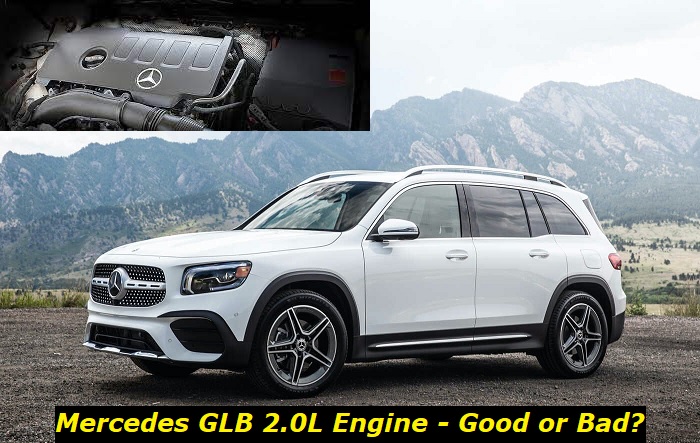To tell you the truth, car journalists don't really love testing and reviewing Mercedes vehicles. These models may have a dozen of available engines. And just to understand what you are dealing with, you need to spend a day researching information in European forums. But still, this is a legendary brand with a bunch of great premium models in its showrooms. So we can't just pass by.
Today, we'll tell you about the 2.0L gasoline engine that you will find in all new Mercedes GLB models in the USA and will talk about its specs and common issues. We'll see how this engine did in other models to get more information and will also tell you what should be considered before you pay that big price for this vehicle.

Key features and my opinion about the engine
- Production years:2018-now
- Average lifespan of M260:160,000-190,000 miles
- Fuel supply type:direct injection
- Power range:190-306 hp
- Fuel efficiency:good
- Engine block material:aluminum
- Engine reliability score:high
- The most common problems:Camtronic problems, carbon buildup on intake valves, additional emission filter potential issues at high mileage.
What should you know about the 2-liter engine in the Mercedes GLB?
So, the GLB is one of the most affordable premium SUVs. It's small, but it's pretty cool. Although it's not really loved in the US now, more and more people tend to ask about this model and consider it as their next car. Why? Simply because it's a Mercedes, it costs less than $40K in its cheapest version and it gives you that great feeling of driving something valuable, not just an average car.
But what kind of engine can you get? All Mercedes GLB models sold in the US are equipped with the same 2-liter turbo gasoline engine codenamed M260. But there are two versions of this engine: the simple one with 221 hp and the top version with 302 hp. They don't only differ with ECU settings, some equipment changes are also there. But technically, these engines are almost identical, they are both M260 engines.
Here's what you should know before you get one:
- this is a turbocharged 2-liter engine that consumes exclusively premium gasoline and offers 221 hp or 302 hp (258 lb-ft or 295 lb-ft);
- the more powerful version is installed in the AMG version and this vehicle is going to cost you over $51,000;
- we believe most buyers will go with the cheaper GLB 250 (or the GLB 250 4Matic) version with the less powerful engine;
- the engine is equipped with the 8-speed dual-clutch transmission (why did you do that to us, Mercedes?) which is slightly tuned for the AMG version;
- the engine is super efficient and offers up to 32 MPG on highways and about 24 MPG in the city which is perfect;
- it will take you just 6.9 seconds to get from 0 to 60 mph in the weaker engine and wonderful 4.9 seconds - in the stronger AMG version;
- the engine is all aluminum but it has cast-iron liners in its block to prolong the life of the whole unit;
- the timing system is driven by the chain which is standard for new Mercedes engines.
One more thing to mention here is the direct injections. Actually, all modern engines come with a direct injection because it enhances gas mileage and gives more power. Also, this engine has the Camtronic system which is actually a phaser that's worth mentioning later in the section with common problems.
The engine technology is pretty simple if you compare it with BMW's modern engines, for example. But it's still a very efficient and pretty cool-to-drive unit that is an obviously good choice for this car. And this is what makes it so good.
How long will the 2.0L engine live in your GLB?
According to open sources, this engine will be able to drive without major issues for more than 150,000 miles. After that, you may get some pretty bad news in terms of the condition of expensive parts and units.
The engine has been manufactured since 2018, so a lot is known now about its durability. We can say that even with perfect maintenance, the 2.0L M260 engine is not likely to live more than 180K miles. After it reaches this mileage, in most cases, it becomes a burden for your budget. Repairing major issues that are super possible at this mileage is just too expensive and isn't worth it.
But still, we have some examples of GLB and other model owners in Europe with mileage of more than 300,000 kilometers which is over 186,000 miles.
What are the common problems with the M260 engine in the Mercedes GLB?
Although the GLB with the 2-liter gas engine seems to be a pretty good purchase, we know about some really bad issues that can happen with this engine way before you will expect it. Some of these issues may be considered common and you just have to know about them to do something and prevent them.
Here are the most concerning conditions that your GLB engine may get into:
1. Engine knocking
You don't expect an ultra-modern Mercedes engine to knock. You actually don't want to hear its work at all. But the M260 engine has its own opinion about this. It may start knocking badly after you fill the tank with regular gasoline. Although these knocks aren't really dangerous at first, they can cause severe problems in the future.
The knocking usually happens because of the detonation and mini-explosion of unburned regular gasoline with too low octane level. When these remains of gas explode, they may gradually damage the block. Even in Europe with its astonishing quality of gas, there were problems with damaged pistons in GLB because of gasoline explosions. So, make sure you buy only high-quality premium fuel for your Mercedes SUV.
2. Camtronic failure
Camtronic is a pretty complicated and technically insane system that controls the phases of the camshaft in this engine. Just like simple phasers, this system is pretty tricky. It has electronics that may just stop working and cause problems.
The worst thing about this Camtronic is that repairing or replacing it will cost you a fortune. This is exactly where you start regretting that you bought a Mercedes. Prices for parts are mind-blowing and dealers will also take thousands for labor. So, would be better if this system was broken before the warranty is over.
3. Direct injection standard problems
Direct injection leads to carbon buildup on intake valves and this will cause unstable idling, loss of power, and also deterioration of gas mileage. If you experience these symptoms in your Mercedes GLB, the best solution would be to just let professionals clean those intake valves. It's a standard procedure that is not that complicated but still is going to cost you some money.
4. Particulate filter and problems associated with it
Along with installing a very doubtful DTC transmission, Mercedes decided to add some surprises here and installed a particulate filter - something like a DPF found in diesel vehicles. We know for sure that this will be another source of problems for all GLBs that have over 150K miles on them. For now, this problem remains unknown because the vehicles are pretty young. But just wait a couple of years.
The problem with DPF is that these filters are extremely expensive and they inevitably get clogged and cause problems.
How can you prolong the life of your GLB 2.0L engine?
Well, here are the best things you can do to avoid soon death of your expensive 2-liter engine in the Mercedes GLB:
- regular oil changes and filter changes should become your religion;
- we highly recommend only Mercedes OEM oil, filters, and parts;
- dealers are your option - no self-taught guys in local garages;
- all error messages and codes should be thoroughly investigated without a delay;
- any engine knocking or loss of power should be addressed right away;
- forget about bad, cheap, regular fuel - only licensed premium gas is your option.
Although these recommendations seem pretty general, they are important for keeping your vehicle on track and avoiding any kind of expensive troubles. Make sure you provide your GLB with a lot of TLC right after you get it from a dealership and till you sell it to the next owner. Otherwise, it may throw some bad news at you anytime.
Final words
So, we want to say that we like this M260 engine by Mercedes. It's small and eco-friendly, and yet it's pretty powerful and fun to drive. In terms of durability, we can't see any significant difference with modern engines from BMW, Cadillac, or some other competitors on the market. But Mercedes gives you something not a single other vehicle can give you. So, it's worth test-driving this car and checking all those advantages by yourself.
Our verdict is simple: this is a good engine that still has some considerations to take into account.
About the authors
The CarAraC research team is composed of seasoned auto mechanics and automotive industry professionals, including individuals with advanced degrees and certifications in their field. Our team members boast prestigious credentials, reflecting their extensive knowledge and skills. These qualifications include: IMI: Institute of the Motor Industry, ASE-Certified Master Automobile Technicians; Coventry University, Graduate of MA in Automotive Journalism; Politecnico di Torino, Italy, MS Automotive Engineering; Ss. Cyril and Methodius University in Skopje, Mechanical University in Skopje; TOC Automotive College; DHA Suffa University, Department of Mechanical Engineering






Add comment